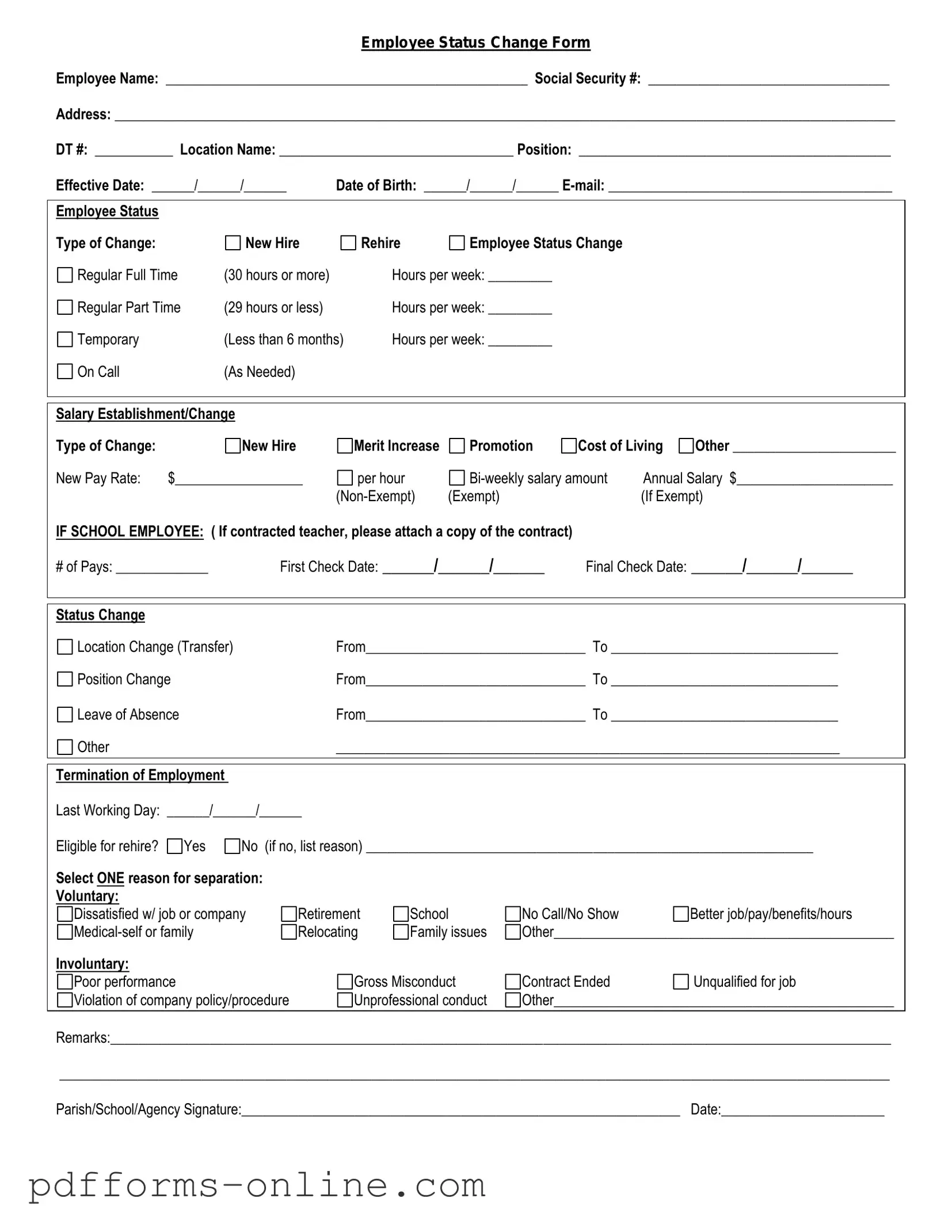The Employee Status Change form is similar to the Job Application form, which is used by candidates seeking employment. Both documents collect essential information about an individual's qualifications, work history, and personal details. While the Job Application form focuses on prospective employees, the Employee Status Change form addresses current employees transitioning to new roles or statuses within the organization. This similarity lies in their purpose of facilitating employment processes and ensuring accurate records are maintained.
Another document comparable to the Employee Status Change form is the Promotion Request form. Employees seeking advancement within the company often fill out this form to formally request a promotion. Like the Employee Status Change form, it requires information about the employee's current position and the desired new role. Both documents help HR track changes in employee status and ensure that promotions align with company policies and procedures.
The Termination Notice form shares similarities with the Employee Status Change form as well. When an employee leaves a company, whether voluntarily or involuntarily, this form is completed to document the end of their employment. While the Employee Status Change form records changes that may lead to continued employment, the Termination Notice form signifies a definitive conclusion. Both forms play crucial roles in maintaining accurate employment records and ensuring compliance with company policies.
The Leave of Absence Request form is another document that resembles the Employee Status Change form. Employees may need to take time off for various reasons, such as medical issues or personal matters. This form captures the details of the requested leave and its duration. Similarly, the Employee Status Change form records changes in an employee’s status, including leaves that may affect their role or responsibilities within the organization.
The Transfer Request form is also akin to the Employee Status Change form. When employees wish to move from one department or location to another, they submit this form to initiate the transfer process. Both documents require information about the employee’s current position and the desired new position. They serve to document internal movements and ensure that HR is aware of changes in employee assignments.
The Performance Evaluation form can be compared to the Employee Status Change form as well. While the primary purpose of the Performance Evaluation form is to assess an employee’s job performance, it can also lead to changes in status, such as promotions or additional responsibilities. Both forms are essential for tracking employee progress and making informed decisions regarding their careers within the organization.
Understanding various employment forms is essential for effective HR management, and among these, the https://documentonline.org/blank-ohio-lease-agreement/ can serve as a useful reference for ensuring that all terms and conditions are clearly outlined, mirroring the role of documents like the Employee Status Change form, which addresses changes for existing employees.
The Benefits Enrollment form shares similarities with the Employee Status Change form, particularly when changes in employment status affect an employee's benefits eligibility. Employees often need to update their benefits information when they experience a change in their employment status, such as a promotion or transfer. Both forms require careful attention to detail and help ensure that employees receive the appropriate benefits based on their current roles.
The Onboarding Checklist is another document that aligns with the Employee Status Change form. While the Onboarding Checklist is typically used for new hires, it can also be relevant for current employees who are transitioning to new roles. Both documents aim to ensure that all necessary steps are taken during an employment change, whether it's welcoming a new employee or facilitating a current employee’s transition to a different position.
Finally, the Employee Exit Interview form can be seen as similar to the Employee Status Change form. While the Exit Interview is used when an employee leaves the company, it provides valuable insights into the reasons for their departure. Understanding these reasons can inform future changes in employee status and help improve retention strategies. Both forms contribute to the overall management of employee transitions and the maintenance of a healthy workplace environment.

